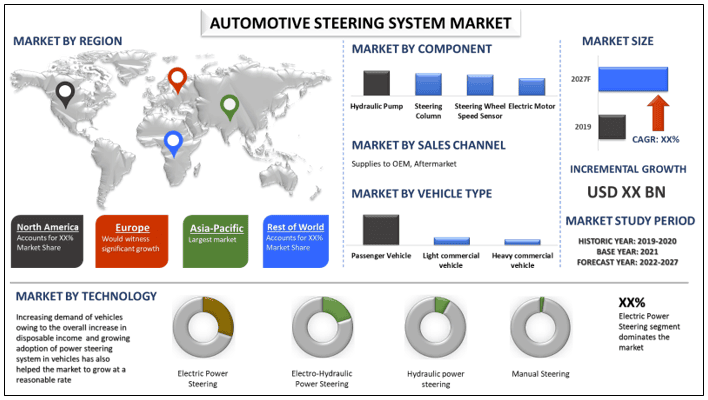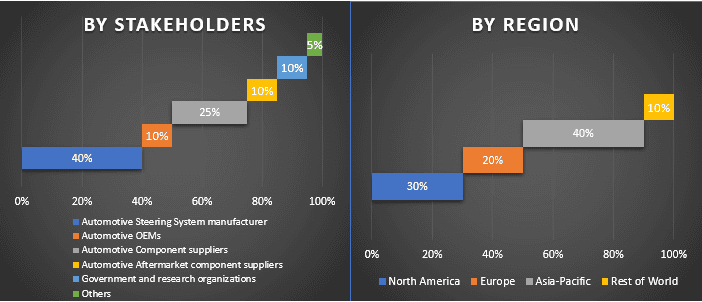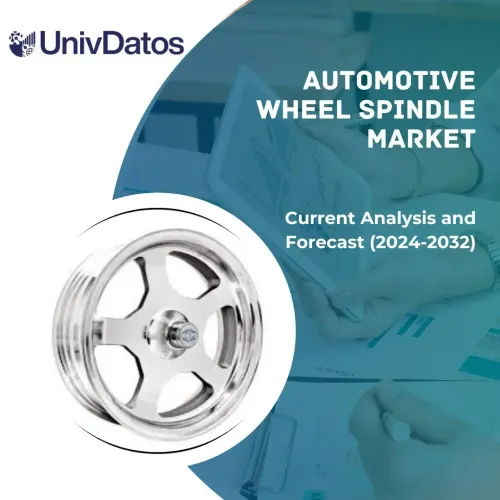
2019年汽车转向系统市场价值约为248亿美元。由于COVID-19大流行导致车辆生产和销量下降,该市场在2020-2021财年出现下滑。对减少碳排放的需求不断增长,促使汽车行业加速电气化几个典型的机械系统。从增压到汽车行业的动力转向,一切都已实现电气化,以最大限度地减少排放,这进一步提高了安全性、操作简便性和更好的驾驶体验。与液压等效系统相比,电动助力转向 (EPS) 系统具有多种优势,包括减轻重量、低维护和燃油消耗,以及在不同车速下改善可变转向响应。考虑到EPS的灵活性,世界各地的汽车制造商正在努力将EPS与其他已在使用中的智能系统集成,以增强车辆安全性和驾驶体验。例如,2018年,玛莎拉蒂推出了名为Ghibli、Levante和Quattroporte的车型,配备了电动助力转向系统,从而可以使用新的驾驶员辅助系统。同样,耐世特汽车公司也将ADAS系统与电动助力转向系统集成在一起,以确保驾驶员的安全。
按地区划分的车辆销量份额,2019年和2020年(%)

2021年8月,耐世特汽车公司扩大了其小齿轮式电动助力转向 (EPS) 系统的输出能力,以满足较重的电动汽车 (EV) 的需求。该公司DPEPS和SPEPS系统的新型高输出选项将转向能力提高了12%到20%,DPEPS最高可达14.5千牛顿 (kN),SPEPS最高可达12.5kN。此外,2021年6月,印度汽车零部件制造商ANAND集团与韩国的Mando Corporation建立了合作关系,以满足印度对电动汽车领域日益增长的需求。新实体“ANAND Mando eMobility Pvt Ltd”将生产和销售两轮和三轮车的电动汽车 (EV) 零部件
报告中提出的见解
“在部件中,方向盘速度传感器细分市场将出现显著增长”
根据部件,汽车转向系统市场细分为液压泵、转向柱、方向盘速度传感器、电动机。由于互联、自动驾驶和半自动驾驶车辆生态系统的最新发展,全球顶级汽车制造商正在优先考虑与汽车转向系统相关的安全问题,主要针对电动助力转向系统 (EPS)。
“在技术中,电动助力转向 (EPS) 细分市场占据主导地位”
根据技术,市场分为电动助力转向 (EPS)、电液助力转向 (EHPS)、液压助力转向 (HPS)、手动转向。2020年,电动助力转向 (EPS) 占据市场主导地位,预计在预测期内将出现显著增长。2016年,电动助力转向 (EPS) 成为汽车转向系统的主流,在全球占据超过50%的份额。
“在车辆类型中,乘用车细分市场占据主导地位”
根据车辆类型,市场细分为乘用车、轻型商用车、重型商用车。由于产量高,乘用车细分市场占据市场主导地位,预计将在整个预测期内保持其主导地位。
“在销售渠道中,供应给OEM的细分市场占据主导地位”
根据销售渠道,市场细分为供应给OEM、售后市场。汽车转向系统主要供应给OEM。欧洲、日本、美国、韩国和中国的汽车制造商在全球占据主导地位。2020年,丰田设法生产了约1050万辆汽车,成为仅次于特斯拉的第二大最有价值的汽车制造公司。大众汽车集团在2020年生产了约1030万辆汽车。
“预计亚太地区将在预测期内占据市场主导地位”
为了更好地了解汽车转向系统的需求,我们对主要地区进行了市场分析,包括北美(美国、加拿大、北美其他地区);欧洲(德国、英国、法国、意大利、欧洲其他地区);亚太地区(中国、印度、日本、韩国、亚太地区其他地区);以及世界其他地区。目前,亚太地区占据市场主导地位。2020年全球所有车辆销量为7798万辆,而2019年为9040万辆。2020年乘用车销量为5360万辆,而商用车销量为2437万辆。2020年,亚洲/大洋洲/中东地区占据所有车辆销量的51.4%,而2019年为48.1%。一些主要市场参与者包括博世、耐世特汽车集团有限公司、捷太格特株式会社、电装株式会社、NSK转向系统有限公司、采埃孚股份公司、现代摩比斯株式会社、Cikautxo India Pvt. Ltd.、三菱电机汽车美洲公司、Mando Corporation。
购买本报告的原因:
- 该研究包括经过认证的行业关键专家验证的市场规模和预测分析
- 该报告快速概览了整个行业的表现
- 该报告深入分析了主要的行业同行,重点关注关键业务财务、产品组合、扩张战略和近期发展
- 对行业中普遍存在的驱动因素、限制因素、关键趋势和机遇进行了详细的检查
- 该研究全面涵盖了不同细分市场的市场
- 对行业进行深度的区域级分析
定制选项:
可以根据要求或任何其他市场细分进一步定制汽车转向系统市场。除此之外,UMI了解您可能有自己的业务需求,因此请随时与我们联系以获取完全符合您要求的报告。
目录
分析历史市场、估算当前市场以及预测汽车转向系统的未来是创建和分析全球转向系统需求和销售的三个主要步骤。进行了详尽的二次研究,以收集历史市场数据并估算当前市场规模。其次,为了验证这些见解,考虑了大量的调查结果和假设。此外,还对整个行业价值链的行业专家进行了详尽的初步访谈。在通过初步访谈对市场数据进行假设和验证之后,我们采用自下而上的方法来预测完整的市场规模。此后,采用了市场细分和数据三角测量方法来估算和分析行业所属的细分市场和子细分市场的市场规模。下面解释了详细的方法。
历史市场规模分析
步骤1:深入研究二手资料:
进行了详细的二手研究,通过公司内部来源(例如)获得汽车转向系统的历史市场规模年度报告和财务报表、业绩演示、新闻稿等,以及外部来源,包括期刊、新闻和文章、政府出版物、竞争对手出版物、行业报告、第三方数据库和其他可靠的出版物。
步骤2:市场细分:
在获得汽车转向系统的历史市场规模后,我们进行了详细的二次分析,以收集主要地区不同细分市场和子细分市场的历史市场见解和份额。报告中包含的主要细分市场包括部件、技术、车辆类型、销售渠道。进行了进一步的区域级分析,以评估全球范围内汽车转向系统的总体需求。
步骤3:因素分析:
在获得不同细分市场和子细分市场的历史市场规模后,我们进行了详细的因素分析以估算当前的市场规模。此外,我们使用因变量和自变量进行了因素分析,例如对个人乘用车的需求不断增长以及汽车行业的技术进步等。分析了历史趋势及其对市场规模和份额的年影响。还彻底研究了供需情况。
当前市场规模估算与预测
当前市场规模测算:根据上述3个步骤中的可行见解,我们得出了当前的市场规模、市场中的主要参与者以及细分市场和公司的市场份额。所有所需的百分比拆分和市场细分均使用上述二次方法确定,并通过初步访谈进行了验证。
估算与预测:为了市场评估和预测,对不同因素(包括驱动因素和趋势、限制因素和利益相关者可获得的机会)进行了权重分配。在分析这些因素后,应用了相关的预测技术,即自下而上的方法,以得出到2027年全球主要地区不同细分市场和子细分市场的市场预测。用于估计市场规模的研究方法包括:
- 行业市场规模,以价值(美元)衡量,以及全球主要地区对汽车转向系统的需求
- 市场细分和子细分的全部百分比份额、拆分和细分
- 以产品形式提供的汽车转向系统市场主要参与者。此外,这些参与者为在快速增长的市场中竞争而采取的增长策略。
市场规模和份额验证
初步研究:与主要国家/地区的主要意见领袖(KOL),包括高层管理人员(CXO/VP、销售主管、市场主管、运营主管和区域主管、国家主管等)进行了深入访谈。然后,对初步研究结果进行总结,并进行统计分析以证明所提出的假设。来自初步研究的输入与次要发现相结合,从而将信息转化为可操作的见解。
不同地区主要参与者的拆分

市场工程
采用数据三角测量技术来完成整体市场估计,并得出汽车转向系统市场各细分市场和子细分市场的精确统计数据。在研究了元件、技术、车辆类型、销售渠道和区域等各个领域的各种参数和趋势后,将数据拆分为多个细分市场和子细分市场。
汽车转向系统市场研究的主要目标
研究中指出了汽车转向系统市场的当前和未来市场趋势。投资者可以从研究中进行的定性和定量分析中获得战略见解,以作为其投资决策的依据。当前和未来的市场趋势将决定市场在区域层面的整体吸引力,为行业参与者提供一个平台,以利用尚未开发的市场,从而获得先发优势。研究的其他定量目标包括:
- 按价值(美元)分析汽车转向系统的当前和预测市场规模。此外,分析行业不同细分市场和子细分市场的当前和预测市场规模
- 研究中的细分市场包括元件、技术、车辆类型、销售渠道和区域
- 对汽车转向系统行业的监管框架进行明确的分析
- 分析涉及各种中间商的价值链,以及分析与行业相关的客户和竞争对手行为
- 报告中分析的主要地区包括北美(美国、加拿大、北美其他地区);欧洲(德国、英国、法国、意大利、欧洲其他地区);亚太地区(中国、印度、日本、韩国、亚太地区其他地区);以及世界其他地区。定义并分析汽车转向系统领域的竞争格局以及市场参与者为在快速增长的市场中保持生存而采取的增长策略
- 行业深度区域级分析
相关 报告
购买此商品的客户也购买了










